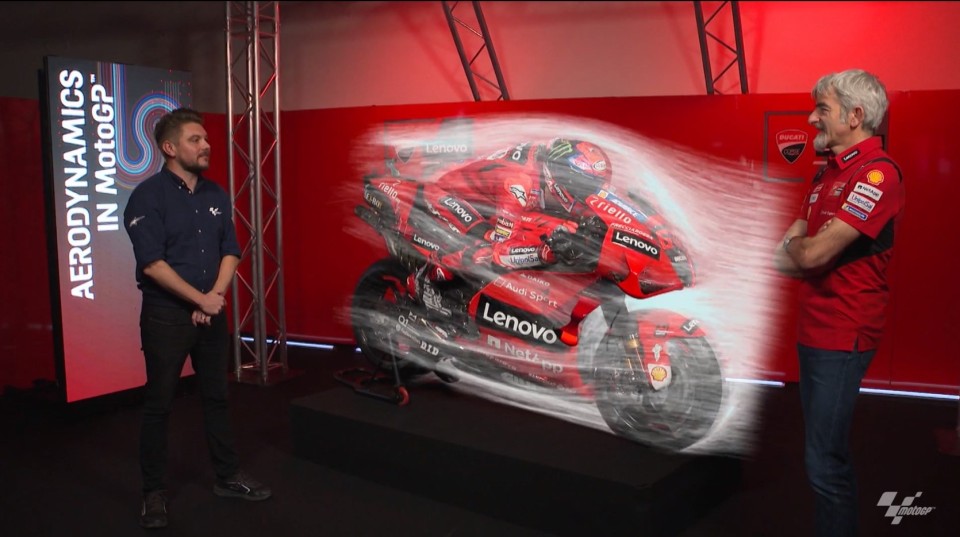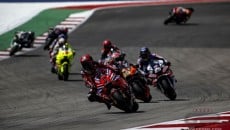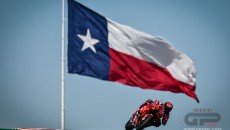The Ducati Corse general manager was interviewed by MotoGP.com commentator Steve Day to illustrate, with the help of the Ducati rider Francesco Bagnaia, the effects of aerodynamics applied to MotoGP prototypes.
"Aerodynamics is a science that helps us make the bike go faster" was Dall’Igna's personal interpretation. In more detail, it is the resisting force that opposes the motion of the vehicle and reduces its performance and in particular its speed. The engineer continued underlining the possibility that emerged in recent years of increasing the load on the front wheel by making adequate use of the wing surfaces. This application translates into a decisive advantage in controlling the wheelie. In general, it improves the stability of the bike by reducing swaying especially at high speed and improves the dynamic behaviour even in the most violent braking that start from a very high speed.
The interpretation from the rider’s side is that "aerodynamics might be the most important thing". Says Bagnaia, highlighting the role of aerodynamics in increasing the top speed on the straight and cornering speed.
"In my opinion, aerodynamics in motorcycles has always been too neglected," explains DallIgna, stressing that only in the last few years has there been an important development in this vehicle design area. Previously, aerodynamics was considered only with a view to improving top speed or to make the cooling of motorcycle components more effective.
Another reason that has contributed to the poor development and application of this science in the motorcycle field is the fundamental role played by the rider and his interaction with the shape of the bike. The bike is designed considering the shape of each rider in the team. It is very important that the shape of the fairing is such as to deform the air flow so that it does not directly hit the rider. The clothing accessories most subject to this type of study are the helmet and the hump on the back of the leathers which together with the fairing constitute the upper profile of the silhouette. The upper and lower limbs of the pilot are not neglected in the study, so other details such as the riders’ boots and gloves are also evaluated. A three-dimensional model is computerized for each rider, thanks to which it is possible to perform aerodynamic studies of the entire bike plus rider system. The fairing gives a different result for each rider.
Bagnaia emphasizes that the rider also actively contributes to better aerodynamic efficiency by trying to bring his body as close as possible to the bike to ensure that there is less exposure to air. A generously sized fairing helps the rider to be more protected from the flow of air and allows for improved top speed. On the other hand, a more contained fairing improves the dynamic behaviour of the bike when cornering.
Ducati uses CFD analysis - computational fluid dynamics - to study various details and their effects on aspects of aerodynamics such as vertical load. This type of approach accompanies the work carried out in the wind tunnel, allowing time and costs to be reduced in drawing up new specifications.
Wings increase safety
“The job of the wings is simply to generate aerodynamic load that allows the front wheel of the bike to remain in contact with the ground”. This is Dall’Igna's summary of the main function performed by the wings. By decreasing wheelie, it is possible to make more use of the thrust of the engine, which is historically one of Ducati’s most valuable points in MotoGP. The Borgo Panigale engine is considered by many to be the state of the art in the category at least in terms of outright performance. The better contact of the wheel with the ground allows the rider to have greater control of the bike thanks to greater stability.
“In this sense, the wings increase the overall safety of the bike”. Worthy of note is this last remark by Dall'Igna, which underlines how the advantage of having a more stable bike overcomes the hypothetical disadvantage according to which the profiles of the wings that protrude from the shape of the fairing could represent a danger for the rider in case of an accident. With this in mind, over the years regulatory limits on the shapes and geometries of the wings have been implemented.
The wings deflect the air flow upwards which in the absence of wing profiles would be horizontal. The flow trend generates a thrust on the surfaces of the wings which increases the load on the front end. The physical phenomenon just presented by the general manager is confirmed through the rider's sensations. Bagnaia confirms that when exiting slow corners, such as those of the Austrian circuit and Turn 15 at Aragon, the aerodynamic load generated on the front wheel counteracts the bike’s natural tendency to wheelie due to violent acceleration. The bike is "glued" to the asphalt. Dall’Igna also underlines the flip side of this solution. It is in fact necessary to find the right compromise between greater vertical load which increases stability and greater resistance which decreases top speed. Bagnaia emphasizes the concept by highlighting that each manufacturer has its own construction philosophy for the wings which then influences the dynamic behaviour. For Ducati it is very important to reach high speeds on the straight which allows for easier overtaking than in the cornering phases.
Cooling
Aerodynamics and the fairing undoubtedly play a fundamental role in cooling. The phenomenon affects not only engine fluids (oil and water) but also brakes and tyres. The greater flow of air that serves to cool the engine components passes through the front fairing and the front mudguard. The air enters the compartment and is deflected downwards both because it follows the descending shape of the rear part of the fender and because it impacts against the radiator. It is also important to let the hot air out and this is possible thanks to the shape of the fairing in the lower part which tends to let the hot flow out laterally. On the other hand, this generates a transverse increase in the wake of the bike.
Adequate cooling of the front brake is necessary, also through the adoption of air conveyors, especially on tracks that severely stress the braking system such as the Spielberg Red Bull Ring. In addition to this, it is also possible to intervene mechanically by installing carbon discs with an increased diameter, within the regulatory limits.
The openings located on the side of the fairing are placed immediately behind the water and oil radiator to eliminate the hot air that has heated up due to its passage through the radiant masses. Dall’Igna emphasizes how the external temperature also affects engine mapping. On tracks where it is usually very hot, it is necessary to intervene on the engine parameters to reduce the problem of detonation inside the combustion chamber which would cause unwanted and uncontrolled explosive phenomena. To do this, it is necessary to reduce the maximum performance that can be expressed by the engine to safeguard its reliability.
The focus then shifts to the correct thermal range of use of the tyres. Given the important weight that tyres have on the overall performance of the bike, dedicated studies are carried out to find out how the tyres, both front and rear, undergo temperature variations. The high temperatures affect the performance of the tyres which, beyond a certain limit, begin to lose grip and wear out more easily.
The ‘spoon'
"What everyone commonly calls a 'spoon' is nothing more than an aerodynamic part that serves to cool the rear wheel". With these words Dall’Igna clarifies the function of the aerodynamic profile anchored to the lower part of the swingarm and placed in front of the rear tyre. The spoon conveys fresh air into the space between the swingarm and the tyre, increasing the heat exchange coefficient thanks to an increase in the relative speed between the air flow and the wheel. The advantages are reflected in less wear on the tyre but also in better grip with the asphalt of the tyre itself.















